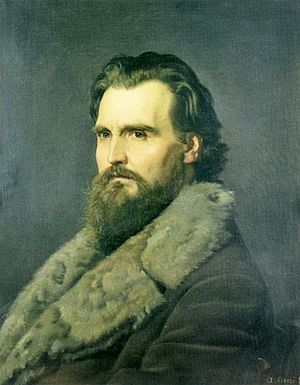Giovanni Dupré facts for kids
Quick facts for kids
Giovanni Dupré
|
|
|---|---|

Portrait of Giovanni Dupré by Antonio Ciseri
|
|
| Born | 1 March 1817 |
| Died | 10 January 1882 (aged 64) |
| Nationality | Italian |
| Known for | Sculptor |
| Movement | Neo-classical marble sculpture |
Giovanni Dupré (born March 1, 1817 – died January 10, 1882) was a famous Italian sculptor. He was known for his beautiful marble sculptures. Many people thought he was one of the best sculptors of his time, second only to Lorenzo Bartolini.
Contents
About Giovanni Dupré
Giovanni Dupré was born in Siena, a city in Tuscany, Italy. He started learning about carving in his father's workshop. He also worked with Paolo Sani, where he helped make copies of old Renaissance sculptures.
Early Career and Famous Works
Giovanni Dupré became well-known after winning a contest at the Academy of Fine Arts in Florence. His winning piece was called Judgment of Paris.
He became even more famous with his life-size sculpture of a dead man, called Abel. This sculpture was bought by Grand Duchess Maria Nikolaievna, Duchess of Leuchtenberg and is now in the Hermitage Museum in Russia. Dupré also made a bronze copy of Abel around 1839. This copy is now in the Galleria d'arte moderna in Palazzo Pitti, Florence.
When Abel was first shown, its realistic style surprised many people. It marked the start of a new art style in Italian sculpture, moving away from the older Neoclassicism. This work also earned him praise from Lorenzo Bartolini. After Abel, he created a more classical sculpture called Cain in 1840. This work is also in the Hermitage Museum.
Dupré also sculpted figures of Giotto and Saint Antonino of Florence. These were made for the outside of the Loggiato degli Uffizi building. He also created a bust (a sculpture of a head and shoulders) of Pope Pius II for a church in Siena.
Later Works and Achievements
During a trip, Dupré saw a funeral monument by Antonio Canova in Rome. This inspired him to create more classical sculptures. After a period of illness, he made the thoughtful sculpture Sappho (1857–1861). This work had a style similar to Michelangelo's. Many art experts at the time said it was his best work yet. It is now in the Galleria Nazionale d'Arte Moderna in Rome.
In 1851, Dupré designed the bronze base for a large table. This table was decorated with beautiful stone inlays of Apollo and the Muses. Dupré's design featured figures of the Seasons with small angels (putti). This table is now in the Palazzo Pitti.
From 1859 to 1864, he sculpted a funeral monument for Contessa Berta Moltke Ferrari-Corbelli. This monument is in the Basilica of San Lorenzo in Florence. He also made the Putti dell'Uva (the "Grape Children") and the Madonna Addolorata for Santa Croce in Florence (1860). For Santa Croce, he also created a large carving above the main entrance. It showed the Triumph of the Cross with figures from different times in Christian history.
Masterpiece and Final Years
In 1863, Dupré created what many consider his best work, the Pietà (1860–1865). This sculpture was made for a family tomb in Siena. It won a top award at an international exhibition in Paris.
Other important works by Dupré include San Zanobi for the Duomo di Siena and the Risen Christ. He also made large sculptures for the Cavour monument in Turin (1872). A bronze bust of Savonarola, made in 1873, can be found in his cell at a monastery in Florence.
Giovanni Dupré's last work was St. Francis for the Cathedral of S. Rufino in Assisi. His oldest daughter and student, Amalia, finished this sculpture. He passed away in Florence before he could complete a sculpture of the Madonna for Santa Maria del Fiore.
Dupré was very respected and served on judging panels for several international art shows. His memories and thoughts on art were published in a book called Pensieri sull'arte e ricordi autobiografici. His daughter, Amalia, also became a well-known sculptor.
Where to See His Works
Many of Giovanni Dupré's sculptures can be found in Tuscany, Italy.
One important collection is in the museum of Siena's Contrada dell'Onda. This museum has a gipsoteca, which is a collection of plaster molds. These molds were used to create many of his famous marble sculptures, including Abel. You can also see molds of two sculptures he made for the Loggia of the Uffizi.
The plaster molds here include two works showing Bacchus as a child. There is also a very touching sculpture of a young girl with angel's wings praying, called Angel of Prayer. You can also see molds of Cain, various busts, and two groups of sculptures with one adult and two children.
Two other beautiful funeral monuments of sleeping baby girls are in the Municipal Museum and the Museum of the Works of the Duomo in central Siena. These are as delicate as his Berta Ferrari monument in Florence.
See also
 In Spanish: Giovanni Dupré para niños
In Spanish: Giovanni Dupré para niños

